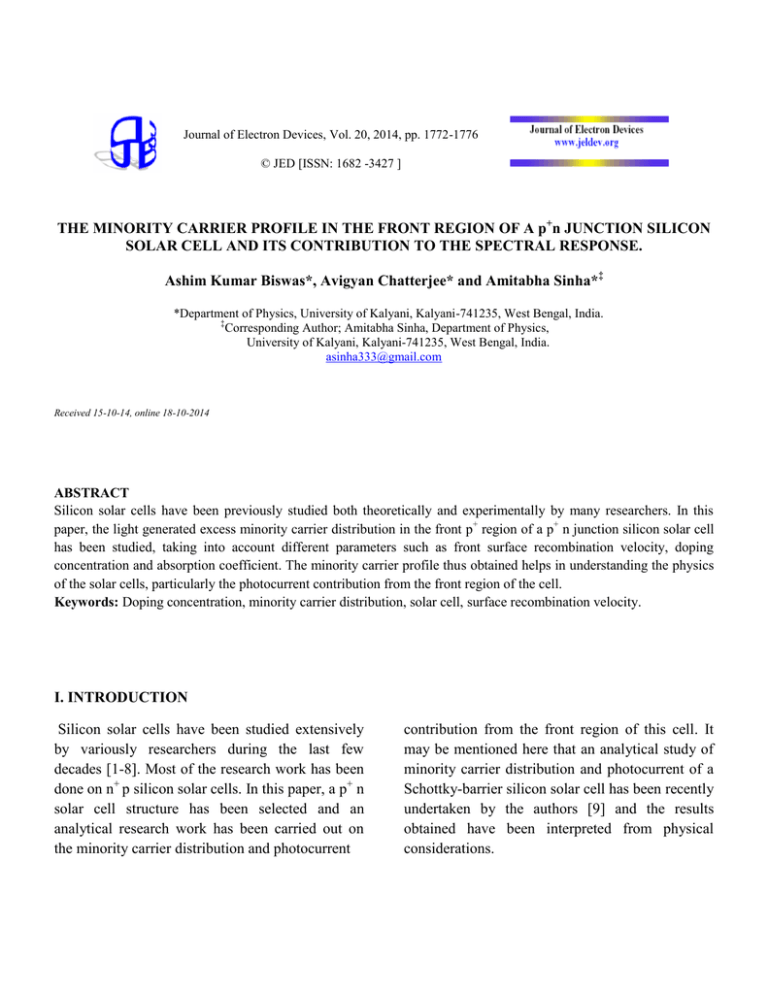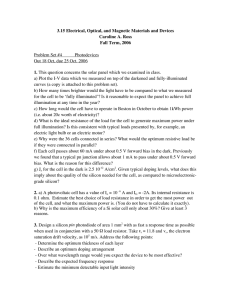The Minority Carrier Profile in the Front Region of a p+n
advertisement

Journal of Electron Devices, Vol. 20, 2014, pp. 1772-1776 © JED [ISSN: 1682 -3427 ] THE MINORITY CARRIER PROFILE IN THE FRONT REGION OF A p+n JUNCTION SILICON SOLAR CELL AND ITS CONTRIBUTION TO THE SPECTRAL RESPONSE. Ashim Kumar Biswas*, Avigyan Chatterjee* and Amitabha Sinha*‡ *Department of Physics, University of Kalyani, Kalyani-741235, West Bengal, India. ‡ Corresponding Author; Amitabha Sinha, Department of Physics, University of Kalyani, Kalyani-741235, West Bengal, India. asinha333@gmail.com Received 15-10-14, online 18-10-2014 ABSTRACT Silicon solar cells have been previously studied both theoretically and experimentally by many researchers. In this paper, the light generated excess minority carrier distribution in the front p+ region of a p+ n junction silicon solar cell has been studied, taking into account different parameters such as front surface recombination velocity, doping concentration and absorption coefficient. The minority carrier profile thus obtained helps in understanding the physics of the solar cells, particularly the photocurrent contribution from the front region of the cell. Keywords: Doping concentration, minority carrier distribution, solar cell, surface recombination velocity. I. INTRODUCTION Silicon solar cells have been studied extensively by variously researchers during the last few decades [1-8]. Most of the research work has been done on n+ p silicon solar cells. In this paper, a p+ n solar cell structure has been selected and an analytical research work has been carried out on the minority carrier distribution and photocurrent contribution from the front region of this cell. It may be mentioned here that an analytical study of minority carrier distribution and photocurrent of a Schottky-barrier silicon solar cell has been recently undertaken by the authors [9] and the results obtained have been interpreted from physical considerations. Ashim Kumar Biswas et al, Journal of Electron Devices 20, 1772-1776 (2014) Considering abrupt p+ n junction having uniform doping in the two regions, the electron current is given by II. ANALYSIS The schematic diagram of a p+-n solar cell is shown in figure (1). . Combining equations (1), (2) and (3) we obtain The general solution of this equation is Figure 1: A p+ n junction silicon solar cell In order to obtain the expression of excess minority carrier distribution and photocurrent of this cell, the method described by Hovel [10] and Sze [11] for an n-p junction solar cell, is followed here for a p+ n junction solar cell. The generation rate of electron-hole pairs as a function of distance x from the surface is given by [10] where Ln= (Dnτn)1/2 is the diffusion length of electrons, A and B are the constants, which may be evaluated using boundary conditions described here [10, 11]. At the surface (x = 0), there will be recombination with a surface recombination velocity Sn. where λ is the wavelength of the incident light, α is the absorption coefficient, F(λ) is the number of incident photons per cm2 per second and R(λ) is the fraction of this photons reflected from the surface. At the depletion region edge (x = xj), due to presence of electric field, the excess minority carrier density falls to zero. The continuity equation for electrons in the p+ front layer is given by Using the boundary conditions, the values of the constants A and B have been determined, which when substituted in equation (5) gives where npo is the thermal equilibrium value of electrons, τn is the life time of electrons and q is the electronic charge. 1773 Ashim Kumar Biswas et al, Journal of Electron Devices 20, 1772-1776 (2014) velocity starting from 10 cm/sec to108 cm/s. The value of absorption coefficient α is taken as 104 cm-1. It is observed from this figure that the value of minority carrier electron concentration is large at the surface for smaller values of surface recombination velocity Sn. The sharp fall in the minority carrier concentration near the surface for larger values of Sn is due to the carrier lost because of the high recombination at the surface for these values of Sn. The expression for the resulting electron photocurrent density from the front (p+) region of the cell is given by The contribution of the spectral response from the front region is thus given by Since the front (p+) region is heavily doped, the lifetime of the minority carrier electrons and also their mobility is dependent on the impurity concentration. The doping dependent lifetime of the electrons have been taken from the formula given by Fossum [12] and the values of doping dependent mobility of electrons have been taken from published literature [13]. Figure 2: Variation of excess minority carrier concentration with distance from the front surface for different values of surface recombination velocity. III. RESULTS AND DISCUSSION Figure (3) shows the distribution of excess electrons concentration in the p+ region, for different values of absorption coefficient α. Here the chosen value of Sn = 105 cm/sec. It is observed that the value of excess electron concentration is small for α = 10 cm-1, whereas it increases significantly for larger values of α. This may be interpreted as follows. Since the wavelengths corresponding to larger values of α are absorbed mostly in the front region, they give rise to more electron-hole pairs, whereas the wavelengths The nature of the photocurrent contribution from the front region can be interpreted considering the minority carrier distribution in this region. For this reason, using equation (8), the excess minority carrier distribution in the front p+ layer has been computed under different conditions. Figure (2) shows the variation of excess minority carrier electron distribution as a function of distance x from the front surface in the p+ region, for different values of front surface recombination 1774 Ashim Kumar Biswas et al, Journal of Electron Devices 20, 1772-1776 (2014) corresponding to smaller values of α are not all absorbed in the front region, but are absorbed in the next n-type base region. This is the reason why the excess minority carrier concentration increases with increasing values of α in the front region. Figure 4: Variation of excess minority carrier concentration with distance from the front surface for different values of acceptor concentration Na. The plot of spectral response due to the front region, as a function of absorption coefficient, corresponding to different values of front surface recombination velocity is shown in figure (5). Its magnitude is higher for lower values of Sn and smaller for larger values of Sn. This may be explained from the fact that for large values of Sn, the recombination at the surface increases, which in turn reduces the contribution of photocurrent. Figure 3: Variation of excess minority carrier concentration with distance from the front surface for different values of absorption coefficient α. Figure (4) Shows the variation of electron distribution as a function of distance x in the p+ region, for different values of acceptor doping concentration Na in the p+ region. It is observed that the value of excess electron concentration increases as the magnitude of Na is increased. This is easily understood from the fact that the electron concentration in the region increases with increase in the doping concentration. Figure 5: Variation of spectral response with absorption coefficient for different values of recombination velocity. The corresponding plot of spectral response due to the front region as a function of wavelength is 1775 Ashim Kumar Biswas et al, Journal of Electron Devices 20, 1772-1776 (2014) shown in figure (6). Since the absorption coefficient of a material depends inversely on the wavelength of light incident on it, it is observed that figure (6) is somewhat complementary to figure (5). This clearly explains the behavior of the spectral response component due to the front layer. support under the DST - PURSE Programme, granted to the University of Kalyani. References [1] [2] [3] [4] [5] [6] [7] Figure 6: Variation of spectral response with wavelength of the incident light for different values of recombination velocity. [8] IV. CONCLUSION In this paper, the light generated excess minority carrier distribution and photocurrent contribution from the front region of a p+ n silicon solar cell has been studied analytically. It is observed that the minority carrier concentration increases with increase in the doping concentration and the absorption coefficient and decreases with increase in the front surface recombination velocity. An explanation has been given for this behavior, and subsequently the spectral response contribution from the front region has been evaluated. [9] [10] [11] [12] Acknowledgement [13] We are grateful to the Department of Science and Technology, Govt. of India, for their financial 1776 D.M. Chapin, C.S. Fuller and G.L. Pearson, “A new silicon p-n junction photocell for converting solar radiation into electrical power”, J. Appl. Phys. 25, 676-677 (1954). W. Shockley and H.J. Queisser, “Detailed balance limit of efficiency of p-n junction solar cell”, J. Appl. Phys. 32, 510-519 (1961). B. Dale and P. Smith, “Spectral response of solar cells”, J. Appl. Phys. 32, 1377-1381 (1961). M. Wolf, “A new look at silicon solar cell performance”, Energy Conversion, 11, pp. 63-73 (1971). A.W. Blakers and M.A. Green, “20% efficiency silicon solar cells”, Appl. Phys. Lett., 48, 215-217 (1986). W. Wang, J. Zhao and M.A. Green, “24% efficiency silicon solar cells”, Appl. Phys. Lett. 57, 602-604 (1990). T.S. Navruz and M.Saritas, “The detailed analysis of auger effect on the efficiency of intermediate band solar cell,” Solar Energy Materials and Solar Cells, 93, 1913-1922 (2009). V. Perraki, “Modeling of recombination velocity and doping influence in epitaxial silicon solar cells”, Solar Energy Materials and Solar Cells, 94, 1597-1603 (2010). A. Chatterjee, A. K. Biswas and A. Sinha, “Analytical Study of the minority carrier distribution and photocurrent of a Schottky - barrier silicon solar cell”, International Journal of Renewable Energy Research, 4, 504-507 (2014). H. J. Hovel, Semiconductors and Semimetals, Vol.11, Solar cells, Academic Press, New York 1975, pp. 1520. S. M. Sze and K. K. Ng, Physics of Semiconductor devices, John Wiley & Sons, 2007, pp. 725 - 730. J. G. Fossum, “Computer aided numerical analysis of silicon solar cells”, SolidState Electronics, 19, 269277 (1976). D.M. Caughey and R.E. Thomas, “Carrier mobilities in silicon empirically related to doping and field”, Proc. IEEE, 55, 2192-2193 (1967).

